Nothing illustrates man’s progression better than the evolution of footwear. From scraps of leather stitched together over 10,000 years ago to the dizzying variety of styles and materials we have today, shoes have kept up with the development of modern man.
But despite the wide variety of choices, most people still find it difficult to find the right footwear. So we have put together a guide with a description of the 20 most common shoe styles plus a primer on how to choose the best shoes for different situations.
Table of Contents
- Shoe styles
- How to choose shoes
- Best shoes for Zumba
- Best shoes for bunions
- Best shoes for standing all day
- Best shoes for doctors, nurses and medical professionals
- Best shoes for overpronation
- Best shoes for Plantar fasciitis
- Best safety shoes
- Best wide fit sandals
- Best extra wide shoes for swollen feet
- Best running shoes for flat feet
- Other types of shoes:
Shoe styles
1. Boat shoe
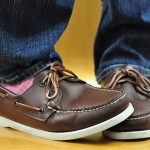 Also called deck shoes, boat shoes were originally designed for use on a boat, with high-grip soles and tough stitching. Today, boat shoes have become a popular casual wear especially in coastal areas. Today’s multipurpose boat shoe comes with a rubber sole, leather outer and the distinct classic stitching of the original design. They are meant to be worn with no socks.
Also called deck shoes, boat shoes were originally designed for use on a boat, with high-grip soles and tough stitching. Today, boat shoes have become a popular casual wear especially in coastal areas. Today’s multipurpose boat shoe comes with a rubber sole, leather outer and the distinct classic stitching of the original design. They are meant to be worn with no socks.
2. Brogue shoe
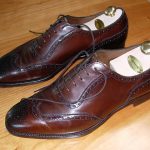 Similar in style but showier than Oxford shoes, brogue shoes are characterized by several leather pieces put together using distinct stitching.
Similar in style but showier than Oxford shoes, brogue shoes are characterized by several leather pieces put together using distinct stitching.
Conspicuous perforations complement the stitching, resulting in what can be best described as ‘elegant chaos’. When first designed, the shoe was meant for outdoor use though today it is perfectly acceptable as business wear.
3. Clog
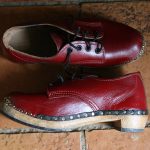 Clogs are shoes made wholly or partly from wood. They are not as common today though you will still find them in some cultures and fashion circles. You are most likely to come across a design consisting of a wooden sole and a leather (or other material) upper. Some brands also apply the name to certain styles of Crocs even though they are not made from wood.
Clogs are shoes made wholly or partly from wood. They are not as common today though you will still find them in some cultures and fashion circles. You are most likely to come across a design consisting of a wooden sole and a leather (or other material) upper. Some brands also apply the name to certain styles of Crocs even though they are not made from wood.
4. Derby shoe
This shoe is very similar to the Oxford with the main difference being the eyelet style. In the Derby shoe, the eyelets are sewn on the topside of the upper. The Derby also has the front end of the lace section open while in the Oxford it is closed.
5. Diabetic shoe
As you might have guessed, diabetic shoes are designed to protect the feet of diabetics. They have a soft interior, a low heel and easy closure method. Diabetic shoes are usually prescribed by a physician or podiatrist although you can still buy them directly at a store.
6. Dress shoe
Dress shoes are not a specific shoe style like a Clog or a Derby shoe. Dress shoes are any type of shoes that are designed for formal or smart casual occasions. They usually consist of neutral colours like brown, black and burgundy. Oxfords, Derby shoes and pumps are good examples of dress shoes.
7. Jazz shoe
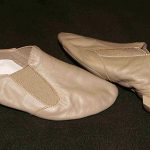 Jazz shoes are designed to provide the stability, comfort and flexibility needed for dancing. They consist of rubber soles for cushioning and tractions and a flexible upper to allow a wide range of foot movement.
Jazz shoes are designed to provide the stability, comfort and flexibility needed for dancing. They consist of rubber soles for cushioning and tractions and a flexible upper to allow a wide range of foot movement.
Depending on the exact type of dance being performed such as hip hop, acro or jazz, the shoes can take on different styles and designs.
8. Loafers
Loafers are an easy going style usually preferred as casual and smart casual wear. The traditional loafer shoe has a moccasin look with a lace-free slip-on design. But many other variations have come up over the years including dressy lace up loafers ideal for formal occasions.
9. Mary Jane
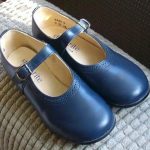 This iconic design is mostly associated with children. The preppy design – semi closed with a buckle strap across the instep – makes it especially ideal for school going girls. A raft of new designs aimed at adults has come up in recent years. They have a toned down preppy design and are more stylish and elegant.
This iconic design is mostly associated with children. The preppy design – semi closed with a buckle strap across the instep – makes it especially ideal for school going girls. A raft of new designs aimed at adults has come up in recent years. They have a toned down preppy design and are more stylish and elegant.
10. Moccasin
Moccasins have their history in several cultures. They originated from indigenous North American Indians, spreading as far as Australia and New Zealand. The shoe consists entirely of leather. The sole is tough unworked leather while the upper consists of a softer variety of leather. Contemporary designs may use other materials and contain additional embellishments.
11. Monk shoe
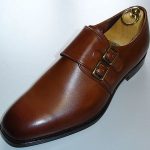 Monk shoes are in the same style curve as Derby and Oxford shoes.
Monk shoes are in the same style curve as Derby and Oxford shoes.
Although they are slightly less formal than Oxfords, they are one of the most popular dress shoe styles.
Compared to Derby shoes, they are more formal with less stitching and usually no perforations on the upper.
12. Orthopaedic footwear
Sandals, shoes and boots designed to accommodate people with various foot problems fall under this category. They can be worn by diabetics and those suffering from corns, bunions, flat feet and hammer toes. As with diabetics footwear, orthopaedic shoes are usually prescribed by a professional though you can also buy them yourself.
13. Oxford shoe
This is the quintessential dress shoe. Its refined and clean look is further enhanced by having a closed laced section and eyelets sewn under the vamp. The shoe is actually named after Oxford University. It can be made from a variety of materials including leather, patent leather, canvas or suede.
14. Platform shoe
They may look like a modern gimmick but platform shoes are quite ancient, going as far back as the 15th century. The typical platform shoe consists of an overly thick sole, either continuously or separated into two – the front part and a stiletto heel. Most platform shoes are for women though you can also find men’s platform boots.
15. Sandals
A sandal is a type of footwear where the upper is consists of straps and leaves most of the upper foot open. Sandals are designed as casual wear especially in warm weather. They can also be worn to manage various foot conditions such as an infection or swelling.
16. Slippers
Slippers fall somewhere between sandals and shoes. They are usually semi-closed and are easy to slip on and off. Unlike sandals, slippers consist of a much more flexible and soft material meant for indoor use only.
17. Sneakers
Sneakers cover a wide range of shoe styles from athletic footwear to casual sporty footwear. Generally, sneakers are light and sporty in style with a rubber sole and synthetic or leather upper. Within the sneakers category, you will find many other sub-categories such as extra wide sneakers, sneakers for overpronation and diabetic sneakers.
18. Steel-toe boot
This extra tough style features a protective steel reinforcement around the toe box. Some shoes substitute the steel for other materials such as aluminium or hard plastic. Steel-toe boots are ideal for construction sites and outdoor activities like hiking. They have also caught on as a fashion statement.
19. Venetian-style shoe
Venetian-style shoes are a variation of the loafer. The main difference is that they are cleaner in style and lack in most of the adornments of loafer shoes. They feature a smooth upper that is slightly open at the instep.
20. Winklepicker
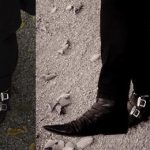 Winklepicker shoes are distinct for their long and pointed toes. While popular a few decades back, today they are common only among certain subcultures. The contemporary Winklepicker shoe you will find on the street will usually have a much shortened toe and thus a less distinct style.
Winklepicker shoes are distinct for their long and pointed toes. While popular a few decades back, today they are common only among certain subcultures. The contemporary Winklepicker shoe you will find on the street will usually have a much shortened toe and thus a less distinct style.
How to choose shoes
Consider your needs and situation when choosing shoes. Why do you need them and what are you going to use them for? Here is a list of common situations and the best shoes for each.
Best shoes for Zumba
Zumba involves a lot of energetic and fluid movements. The best shoes for the dance cum workout routine are those that balance between flexibility and firm balance. If the shoes are too firm, you will not have the flexibility you need to move. But if they offer no traction, you could easily end up on the floor and even hurt yourself.
You could buy dance shoes designed specifically for Zumba although they might be pricey. Sneakers are also great thanks to their lightweight and flexible nature. If you already own a pair of lightweight trainers, you can also use those for Zumba especially if you only do it occasionally.
Best shoes for bunions
If you expose a bunion to continued pressure and friction, it could get inflamed and become painful to the point where walking is a problem. When buying shoes for bunions, only go for those with a wide fit. The toe box should be especially roomy to avoid any aggravation on your bunions.
Additionally, the upper should be soft such that it adapts to your foot’s shape and size without applying painful pressure. A soft insole can also help cushion your joints especially when you are running or walking.
Best shoes for standing all day
Comfort and support. Those are the two most important words to keep in mind if you need shoes to help you cope with long hours spent on your feet.
The shoe you buy should be designed in such a way that it helps the arch absorb some of the pressure being exerted by your body. So look for shoes with good arch support. Secondly, the insole should be soft to cushion the continued pressure and prevent your muscles and tendons from aching.
If you can get shoes with a breathable upper the better. They will keep your feet cool and dry especially in warm weather.
Best shoes for doctors, nurses and medical professionals
If you work in a hospital or clinic, most of your day is probably spent standing or walking. Again, comfort and support are extremely important. You want a pair of shoes that is going to cushion your footfalls and provide added support to your already overworked leg muscles and joints.
Most medical professionals opt for comfortable and light trainers. They have the added advantage of being breathable. Some shoes made specifically for medical settings come with anti-microbial protection.
Best shoes for overpronation
Overpronation is one of those problems that, if not corrected quickly, gradually gets worse and could lead to even worse issues.
Shoes for overpronation are designed to cancel out the lack of raised arches. They come with built-in arch support that prevents the foot from rolling excessively when you are running or walking. They’ll also feature a cushioned insole that absorbs shock when you are in motion.
If you have flat feet, you most likely suffer from overpronation. Whether you are buying trainers, sandals or work shoes, make sure they offer good arch support, balance and shock absorption.
Best shoes for Plantar fasciitis
Plantar Fasciitis affects the ligaments (thick band of tissue) that support your arches which in turn support your body. Plantar fasciitis causes pain when you stand up or move. A good pair of shoes with adequate arch support and insole cushioning can mitigate the problem.
Arch support from the shoes prevents your feet ligaments from straining further and causing more pain. A soft insole reduces the pain you feel when you walk or run and prevents any further aggravation to the ligaments.
Shoes for Plantar fasciitis should also prevent overpronation, which is one of the most common factors behind this condition.
Best safety shoes
If you work in a factory or a construction site or if you spend a lot of time outdoors, foot protection is essential. You need to be careful about objects falling on your feet or your toes running into hard objects.
Steel toe shoes are the most popular safety shoes. They feature a steel cap (various other materials such as aluminium are also used) around the toe box to protect your toes.
Other safety shoes without steel caps will simply use a tough outer material that protects your entire foot.
Another essential feature of safety shoes is a thick and hard sole that can resist high temperatures, sharp objects and most chemicals.
Best wide fit sandals
Wide fit sandals are ideal for those with extra wide feet or those with certain foot conditions such as bunions and hammer toes.
When buying wide fit sandals make sure they also provide adequate support. If they feel too loose, they will cause pain and discomfort. They should also be comfortable.
Best extra wide shoes for swollen feet
Feet can swell as a result of various conditions such as diabetes or kidney disease. Even pregnant women sometimes experience swollen feet and ankles especially late in their pregnancy.
Make sure that the shoes you buy are extra roomy. They will usually be marked as EEE or simply Extra Wide’. The upper should also be soft to avoid aggravating your already swollen and sensitive feet. Same goes for the innersole which should provide soft cushioning as you walk.
One other tip: get shoes that can be adjusted using either a buckle or Velcro strap. This way, you can adjust the fit depending on whether the swelling goes up or down.
Best running shoes for flat feet
In the wrong shoes, running can be brutal to flat feet. Your feet, already unable to fully support your weight, are exposed to blow after blow of damaging shock.
With little support from the shoes, they roll inwards too much when your foot comes down (overpronation) causing pain and a host of other problems. There is also no cushioning to absorb the shock and protect the joints and muscles.
Good running shoes for flat feet should focus on two things: arch support and shock absorption. The first is fulfilled through a proper heel and mid-sole design while the second is achieved by using a cushioned insole.




